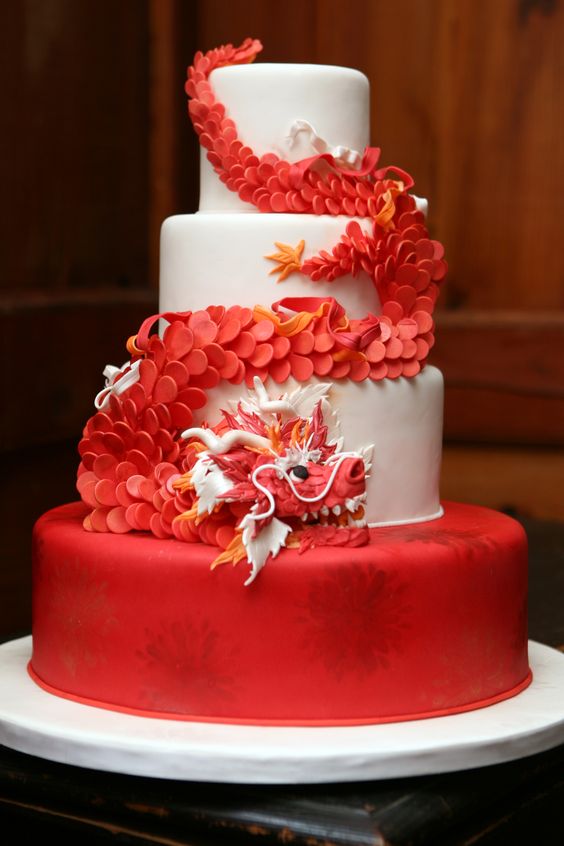
While having lunch with my lovely future bride from Japan and her mother while we were scouting chateau venues in France we spent an unforgettable 4 hour meal while they were explaining to me the traditional japanese wedding. The couple had decided to have an intimate wedding in France with their close family and friends at the exquisite Chateau de Chantilly. Yet to give pleasure to their parents they would be having a more traditional wedding in Japan. Some of the traditional aspects were brought into the wedding in France such as the tea ceremony and the traditional outfits. The future bride explained the wonderful process. The choice of the wedding date is determined usually by your grandmother or family member that will consult a Feng Shui specialist. It depends on the bride and grooms birth dates and other factors which determine the date of the wedding in order for them to have most prosperous life. For instance, here are the Auspicious wedding dates for the first half of the year 2017.

Auspicious wedding dates in 2017.
Usually the tea ceremony that is held with the family members is held very early in the morning ranging from 8 am to 10 am depending again on the feng shui timing. This means the lovely bride and her trusted bridesmaids usually have to get up at 4 am to be ready and looking glamourous at 6 am for the door games before the tea ceremony! The groomsmen and groom need to go to the location of the future bride and in order to reach her they need to play different games commonly called Door games. They are one of the unique segments that can only be found in Chinese and Japanese weddings. Traditionally meant to create barricades to prevent the groom from taking the bride away from her home, this part of a Chinese wedding has evolved to be filled with fun and games, aimed to make the groom prove his love to his future wife. It usually starts with bridesmaids and family members of the bride asking for red packets ( Lai-See) ( meaning red envelops with money) Usually the number requested in the bargaining has a 9. So, maybe 99 or 999 and so on. The number 9 represents ‘eternity’ in Chinese, therefore a lucky number for marriage. Before letting the groom and his groomsmen enter their room and this often involves a fun round of bargaining before the men are finally let in. What ensues is a series of games and tests that the groom has to go through, usually accompanied by his groomsmen, Games can range from putting on funny wigs to reciting poem and eating horrible sweets, the brides can ask Trivia regarding the bride and grooms relationship and if they give an inocorrect answer the groomsmen have to do push ups. The boys can be asked to dress in tight leotards and bras and dance to a song chosen by the bridesmaids. A marriage may go through the following four flavours… Sweet, Sour, Bitter and Spicy. So to test the grooms ability of being able to cope with what marriage may bring, ask the guys eat or drink something of each flavour… it needs to be VERY Sweet, VERY Sour, VERY Bitter and VERY Spicy such as Wasabi All these fun games end with the groom and groomsmen finally being able have access to the bride. Following the door games is the tea ceremony. We will tell you everything you need to know about it in the next section of this post.
1. Superstitious Slumber Party
The night before the wedding, the bride returns home to her parents’ house with her bridesmaids, while the groom heads off to his parents’ home. The bride and groom (separately) wash their hair in water infused with pomegranate leaves, which are believed to ward off evil. Then they have their hair combed by a woman who is said to be “lucky”—she is chosen based on your personal opinion of what is considered to be fortunate (e.g. someone who has many children). She combs the couple’s locks four times, and each stroke bears a special meaning: The first is so that the marriage will last forever, the second represents harmony in the union, the third is for fertility, and the fourth is for good health and fortune.
2. Four Points for Your Mother-in-Law
The following morning, the bridesmaids arrive (if they didn’t stay over the night before), and they all get their hair and makeup done together. Sounds normal so far, right? During this time, the bride is given four “points” of gold, which consist of a necklace, pendant, bangle, and earrings. The mother of the groom usually gifts the jewelry to welcome her new daughter. Back in the day, only yellow gold was allowed, but these days, white gold or silver is permitted also.
3. Orange You Fortunate
Before the wedding, family elders—who sought religious or non-religious counsel—determine an auspicious time for the groom to come to the house and “collect” his bride. He usually brings an entourage of boys and waits for the younger brother (or cousin) of the bride to open his car door before exiting. Once this relative opens the door, he hands mandarin oranges to the groom in exchange for a red, traditional envelope used during special occasions, like Chinese New Year. The oranges stay in the car for good luck.
4. The Groom Challenge
So why does the groom need all of his male pals and relatives present? Because his entry into the house is met with a series of challenges by the bridesmaids! While the bride waits with her parents in anticipation for her groom, the ladies-in-waiting are outside, armed with tests and games for the groom. This tradition is symbolic of the bride’s family’s love and their unwillingness for their daughter to leave the family. Nowadays, it’s more of a chance for the girls to see how far the groom will go for his bride. We’re talking anything from having to eat wasabi at 10 a.m. to doing handstands with all of his groomsmen! This usually ends with the girls bartering for an “entrance fee” of sorts. The denomination has to be an even number. Once the groom is granted permission into the house, he gets to see his bride, lift her veil, and kiss her! Sounds familiar, no?
5. Tea Ceremonies
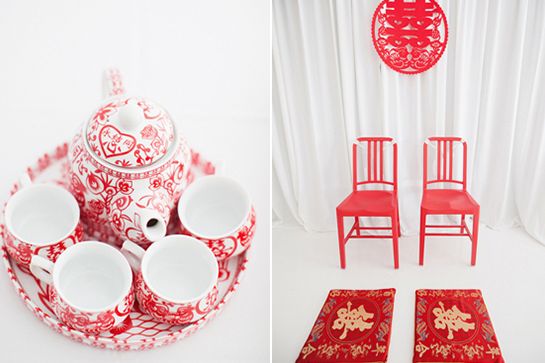
Chinese tea ceremony.
Given that tea is an important part of Chinese culture, it’s not surprising that it’s part of a traditional Chinese wedding. Once the groom passes his wedding test, both bride and groom serve tea to her family and are expected to serve it in a gaiwan to both sides of the parents, representing an important moment in which members of both families become relatives of each other. On this page, we’ve documented all the information you need to know to get ready for your wedding, or organize a Chinese wedding tea ceremony for someone close to you. Once again, the tea must be made by a very lucky lady, much like the one who combed their hair the night before. Then they head off to the groom’s family, where the bride must change into a traditional Chinese wedding outfit to serve tea to the groom’s family. The tea must be made with longans (aka “dragon eyes”) and dates to symbolize fertility and male offspring (the Chinese still have strong beliefs about the importance of bearing male children to keep the family going). When the couple serves tea to his family—which has now become her own—they are given red envelopes with money and sometimes even gold jewelry, which the bride must put on immediately. Chinese Wedding Tea Ceremony History In a traditional Chinese wedding, the tea ceremony is one of the most significant events. It includes very formal introductions of the bride and groom and shows respect to their families. The earliest written record of tea ceremonies emerged during the Tang Dynasty over 1200 years ago. It was initially called cha dao (茶道)or the way of tea.couples choose to show respect to both the bride and groom’s families by hosting tea ceremonies for both sides. The meaning of a Chinese wedding tea ceremony In China, serving tea when guests come is a very traditional propriety. It is a significant way to show respects. In the wedding, this act is in respect and gratitude to her parents for all the years of love and care. Besides this, tea ceremony is much meaningful in a wedding. Tea is the symbol of purity, stability and fertile. The purity of tea represents the love is pure and noble; the stability of tea stands for faithful love; the fertile of tea represents the family will have many children. 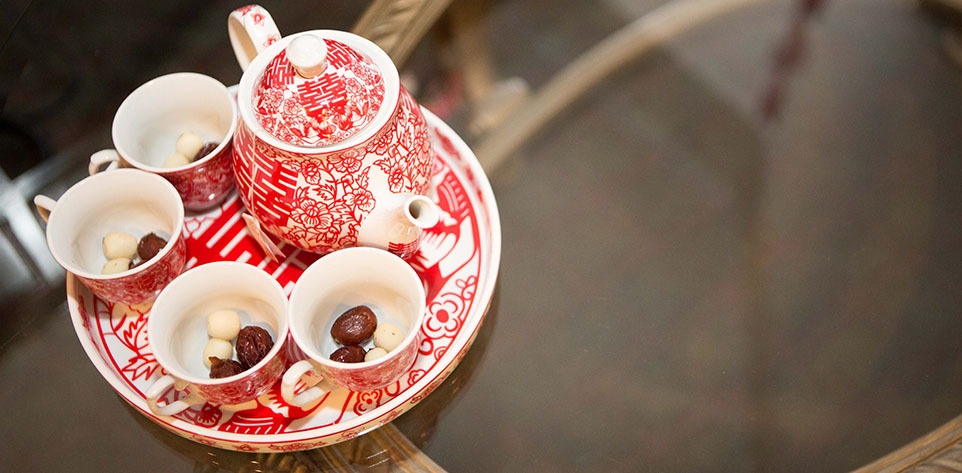 Chinese wedding tea ceremony steps 1 Organize positions – During a Chinese wedding tea ceremony, the groom should stand on the right and the bride should be on the left side. Their parents should sit on chairs and wait for the new couples’ kneel and tea serving. 2 Communicate order of serving – The order of serving tea is very important. It shows how the couple respect their seniority. The parents will be served first, then the grandparents, grand uncles and aunts, uncles and aunts, and then elder siblings. 3 Educate on serving étiquette – Below we’ve listed some traditional serving etiquette.
Chinese wedding tea ceremony steps 1 Organize positions – During a Chinese wedding tea ceremony, the groom should stand on the right and the bride should be on the left side. Their parents should sit on chairs and wait for the new couples’ kneel and tea serving. 2 Communicate order of serving – The order of serving tea is very important. It shows how the couple respect their seniority. The parents will be served first, then the grandparents, grand uncles and aunts, uncles and aunts, and then elder siblings. 3 Educate on serving étiquette – Below we’ve listed some traditional serving etiquette.
Serve tea with two hands holding the saucer and bow slightly forward (or kneel). Make sure parents don’t have to move or stand up to receive the gaiwan. (also watch the video in the beginning of this article)
Those receiving the tea should not hold the cup but the saucer as the gaiwan cup itself can be hot. It’s recommended let everyone know this in advance.
It can also be good to educate people on how to drink from a gaiwan. The most traditional way is to hold the saucer to move the cup close to your mouth. Then lift the lid slightly to one side and drink. When moving the lid, you can hold the nob on the lid, which isn’t hot.
Once they’ve drank the tea, they take back the gaiwan with two hands, once again by holding the saucer.
Gifts are now presented, which we discuss in the next section.
Chinese wedding tea ceremony gifts guide
After the drinking of the tea, gifts for the bride and groom will be presented. If it’s your first time attending such a ceremony, you might be worried about what Chinese wedding tea ceremony gifts are suitable. Well you really don’t have to, since gifts are usually in forms of red envelopes with money that can widely ranges from 50 to 500 USD. These red envelopes are also called ‘lai see’ in Hong Kong and the Guangdong province, while in other areas in China they’re know as ‘hong bao‘. Brides family needs to give gold so much it doesnt fit in their arms. Elders give money and gold jewelery. And, parents, grand-parents and uncles give money of brides side. How much money to put in a red envelop? It’s very hard to give you an indication of what amount is suitable as it really depends on the family situation and traditional practice. This vary widely across families and different regions in China. If you’re not sure, you should ask someone in the family first. It’s better to be embarrassed asking, then feeling embarrassed when giving a too low amount. Parents, grandparents and some closely related relatives sometimes also present jewellery as a gift. It’s good to know that, the couple should wear the jewellery immediately as a sign of appreciation. To the younger siblings and cousins who help them serve tea will be blessed with a happy marriage or abundant wealth. These ‘helpers’ also receive lucky red envelopes filled with money. 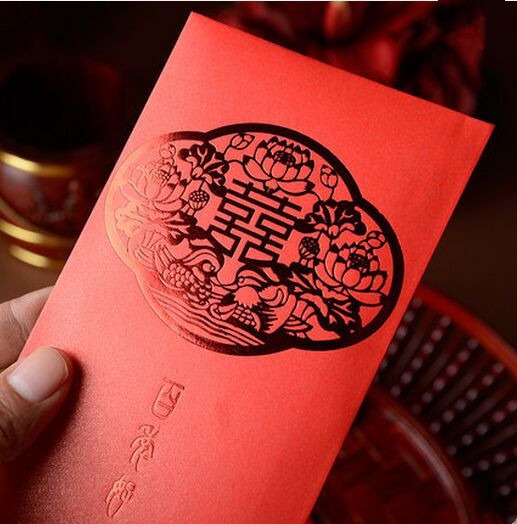 What kind of Chinese tea is suitable? Any sweet tea that symbolizes sweetness is good for the Chinese wedding tea ceremony. It is believed to bring happiness to the couple and to foster good relations between the newlyweds and her new in-laws. Tip : the Chinese wedding tea set is a meaningful keepsake of the wedding and an important gift from the bride’s family. It can be a family heirloom as well. In the future when the couples’ children get married, the tea set will be used and presented. Given this, it might be great to ask the parents first, if they have a suitable antique gaiwan before considering buying a new one. In a Chinese wedding tea ceremony, a suitable dress is necessary. Bride and groom need to dress in red silk and the tulle veil should be red too. Tang suit and Hanfu (Most famous traditional costumes in China and known to the world) are most popular. Some popular design such as dragons and phoenix on the dress would be suitable for decoration.
What kind of Chinese tea is suitable? Any sweet tea that symbolizes sweetness is good for the Chinese wedding tea ceremony. It is believed to bring happiness to the couple and to foster good relations between the newlyweds and her new in-laws. Tip : the Chinese wedding tea set is a meaningful keepsake of the wedding and an important gift from the bride’s family. It can be a family heirloom as well. In the future when the couples’ children get married, the tea set will be used and presented. Given this, it might be great to ask the parents first, if they have a suitable antique gaiwan before considering buying a new one. In a Chinese wedding tea ceremony, a suitable dress is necessary. Bride and groom need to dress in red silk and the tulle veil should be red too. Tang suit and Hanfu (Most famous traditional costumes in China and known to the world) are most popular. Some popular design such as dragons and phoenix on the dress would be suitable for decoration.
Chinese Wedding Dress
The color red is considered good luck, a strong color that can drive away evil spirits. The traditional Chinese wedding dress in northern China usually is one-piece frock named Qi Pao, embroidered with elaborate gold and silver designs. Brides from southern China usually wear two-piece dress named Qun Gua, Kwa or Cheongsam, also elaborately adorned with golden phoenix and dragon. In the old days, a piece of red veil is part of the bride’s costume to cover her face during the wedding ceremony. Newlyweds would see each other’s face for the first time in their lives at their wedding night. In modern Chinese wedding, the bride changes dresses at least 3 times at the wedding day. She would start with western style white wedding gown for a church for civil ceremony. Then at the tea ceremony, she would change to traditional Chinese bridal dress, which she will wear to the reception too. Before the end of the banquet, she would change into a cocktail dress, and great the guests, and then see them off at the door, thus this dress is also called “Song Ke” dress. How many times the bride changes and what kind of dress she wears ? The bride changes dresses a few times during the wedding while the groom changes once or does not change. In the morning, the bride is usually dressed in traditional Chinese wedding gown. She won’t change until after she has served tea to her in-laws. Then she changes to western style white wedding gown for the ceremony in which the newlyweds will bow to the heaven and the earth, the ancestor’s tablets and to each other. At the wedding banquet, the bride changes to a formal day time gown, and the newlyweds will serve wine to every guests at the wedding. The last one is a night gown she wears when she sees the guests off at the end of the banquet. The groom usually is dressed in a Chinese men’s traditional gown in the morning, then change to cocktail suit before the banquet.. It is also acceptable to wear a formal suit instead of cocktail suit…
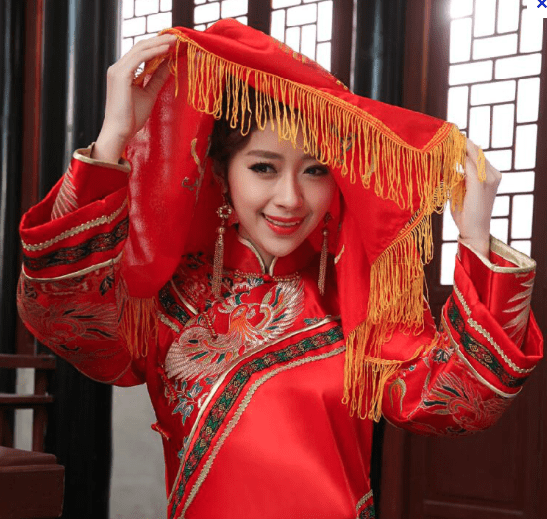
A Chinese bride wearing her red veil.
Chinese wedding food and wedding cake.
Certain types of food are commonly served at the Chinese wedding banquet, which include fish, roast suckling pig, pigeon, chicken cooked with red oil, lobster and desert bun with lotus seeds stuffed inside. The pronunciation of fish is the same as “abundance”, meaning the newlyweds will have plentiful of wealth. Roast suckling pig is usually served whole, a symbol of the bride’s purity (virginity). Pigeon implies peaceful future. Chicken also means phoenix, cooked in red oil to symbolize the wish for a prosperous life ahead for the newlyweds. Lobster is literally called “dragon shrimp” in Chinese. Having lobster and chicken together at wedding banquet indicates that the dragon and the phoenix are hormones together, and the Yin and Yang elements in this family is balanced. Chinese wedding cake. There is more than one type of Chinese wedding cake. There is the traditonal ‘Double Happiness‘ or ‘Dragon and Phoenix cake’ due to the imprints of dragons and phoenixes on the cake. Traditionally the groom’s family gives these old-style Chinese cakes to the family of the bride. Some of these cakes are used to worship or revere the ancestors, while the rest may be sent with the wedding invitations to guests. For the wedding reception, the wedding cake is a large, multi-layered construction. As red is a dominant wedding theme with the Chinese, their wedding cakes are often red with symbols denoting happiness and prosperity. 